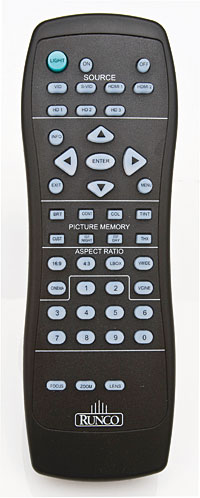Runco Q-750i LED DLP Projector Page 2
Runco also includes two expanded color gamut features that are more unusual. One of these is a DCI Color Gamut, which artificially expands the Color Gamut to emulate the wider gamut that commercial movie theaters use for Digital Cinema presentations. The second choice is even more out there (literally). Runco Smart Color has the kind of colors that jump out at people when those dastardly dynamic modes are engaged on flat-panel HDTVs on bright showroom floor. The twist is that the algorithm is claimed to pump up the other colors but leave the fleshtones looking natural. In fact, the Q-750i’s user manual says RSC will “improve the accuracy of fleshtones and increase color saturation.”
 My initial response to all of that was, “Oh, yeah?” We’ve been measuring adherence to the HD color standard for years for a reason. Display manufacturers love to market HD displays of all types around wider color gamuts, but the fact is that if you’re simply imposing a wider gamut on playback than the HD standard, it’s inherently and undeniably inaccurate. You might love the way your HDTV looks with an expanded color range, but understand that none of the standard- or high-definition program material you watch on your HDTV is mastered with a wider color gamut. The DCI color space is only used for video masters shown in theaters. It is not used to master home video transfers on Blu-ray Disc or any other consumer format. It’s simply artful deviation in this realm.
My initial response to all of that was, “Oh, yeah?” We’ve been measuring adherence to the HD color standard for years for a reason. Display manufacturers love to market HD displays of all types around wider color gamuts, but the fact is that if you’re simply imposing a wider gamut on playback than the HD standard, it’s inherently and undeniably inaccurate. You might love the way your HDTV looks with an expanded color range, but understand that none of the standard- or high-definition program material you watch on your HDTV is mastered with a wider color gamut. The DCI color space is only used for video masters shown in theaters. It is not used to master home video transfers on Blu-ray Disc or any other consumer format. It’s simply artful deviation in this realm.
With all that being said, believe it or not, I wasn’t totally down on RSC going in. What if, like me, you don’t like the Crayola look for movie night, but maybe you want to leave on a few lights to choke down some dinner or have a few beers when the big game or the big fight is on? If you could really pump up some of the colors while not making fleshtones look too out of whack, that might be a good solution for not completely darkened viewing. What I found in practice wasn’t exactly that. The first program I tried RSC with was boxing on HBO HD. With the boxers being shirtless, RSC seemed to exaggerate some parts of their complexions more than others, almost rendering a splotchy look. It was distracting, and I quickly disengaged it. I tried it with a couple of movies and found a similar effect on closeups of actors and actresses, who often have more or less makeup applied to different parts of their faces and necks. I again found the experience distracting in its uneven treatment of fleshtones that covered larger areas of the screen.
You might like this feature more than I do, and it might work better on different program material or even with different room lighting than the warmish lighting in my theater space. The important thing is that while Runco allows its customers to choose these artful deviations from accuracy, you can always push a couple of buttons and get right back to a superb level of accuracy that very few manufacturers are providing.
The Nature of the Beast
The two LED projectors I’ve used so far—this Runco and the Vivitek H9080FD (HT, June 2010)—are throwbacks in one respect. They’re big. Not exactly as big as in the CRT days, but not one of those svelte, shoebox-sized digital PJs, either. The Runco’s substantial silver and black casing is reasonably attractive, but I have a couple of gripes. You must open the back panel to access the power cable inlet and the dual HDMI 1.3 connections on the back. It’s more difficult to open and close than it needs to be, but once you’re done, the cabling is pretty stealth. Much more bothersome is the fact that you have to partially disassemble the front panel to access the manual horizontal and vertical lens shift options, which are a must for properly aligning the image on the screen. Alignment needs to be fine and precise. Here, it’s impossible to reassemble the front panel without knocking your adjustments back out at least a little. After several tries, I simply had to live with some overcompensation instead of precise alignment. Even if you use a substantial ceiling mount, this will be an issue. I’d really like to be able to make these adjustments without disassembling and reassembling the front panel.
Runco specs this projector for screen sizes from 72 to 92 inches wide, and that’s on the money. For my 92-inch-wide screen, the standard lens option offered a zoom range of just over 14 feet to just over 18 feet. The light output on my screen was nearly 15 foot-lamberts set up very conservatively, with no clipping above white. With my screen and blackout room, this was plenty punchy. I wouldn’t go bigger. Keep in mind that while it isn’t huge by front-projection standards, my 92-inch-wide screen is over 100 inches diagonal. For those of you keeping score at home, that’s more screen area than four 50-inch flat-panel HDTVs.




























































